Before Starting A Clover Lawn: A Must Read!
- May 31, 2024
- 0 comment
Clover was a popular choice for lawn cover back in the 1950s, and it’s easy to see why. Not only does it require minimal attention and water, but it also transforms into a stunningly beautiful green space once fully grown. If you’re considering bringing this classic look back to your yard, here’s everything you need to know about starting and maintaining a clover lawn.
Understanding Types of Clover for Lawns
When choosing clover for your lawn, you have two main options: white clover (also known as Dutch clover) and microclover. Each type offers unique benefits suited to different landscaping needs.
Microclover
Known for its compact growth, microclover has a robust root system that handles foot traffic exceptionally well, making it perfect for high-use areas like sports fields or playgrounds. This variety was specifically engineered to be integrated into athletic turfs along with grass, providing a durable and uniform playing surface.
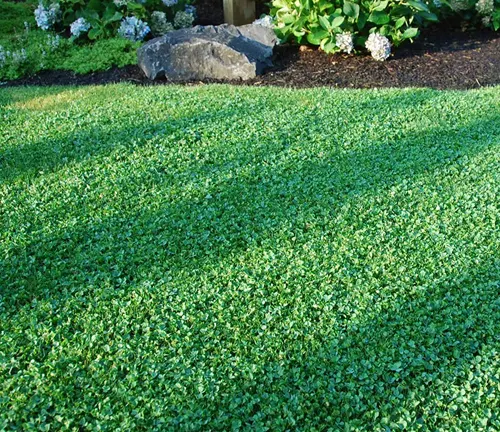
White Clover
As the more traditional choice, white clover is favored for its cost-effectiveness and natural beauty. While it has not been genetically modified specifically for lawns, its popularity stems from its affordability and adaptability. However, it’s worth noting that frequent mowing can encourage a denser growth form, but at the expense of seed production. This means that while the lawn may become more compact, it might also require reseeding more frequently to maintain its vitality over the years.
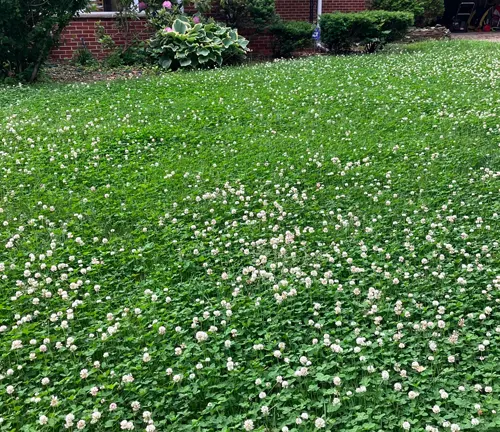
Benefits and Drawbacks of Clover Lawns
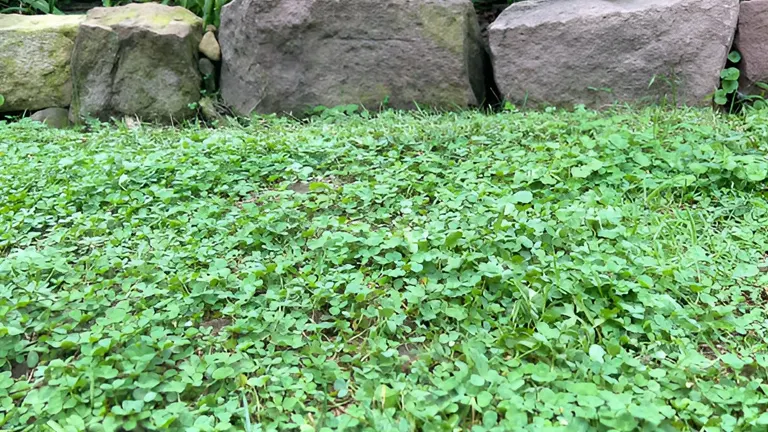
Clover lawns offer a range of benefits that make them an attractive choice for eco-friendly and low-maintenance landscaping:
Benefits
- Nitrogen Fixation: Clover is a powerhouse when it comes to enriching soil naturally. As part of the legume family, it captures nitrogen from the air and fixes it into the soil, which reduces the need for synthetic fertilizers and enhances overall soil health.
- Drought Assistance: Although not inherently drought-resistant, clover supports the survival of surrounding plants during dry spells. Its deep taproot system reaches the water in deeper soil layers, which it then brings closer to the surface, benefiting the entire lawn ecosystem.
- Weed Suppression: Thanks to its vigorous germination and growth, clover outcompetes most weeds. This characteristic allows it to dominate a lawn space, thereby reducing the need for frequent weeding and the use of herbicides.
Drawbacks
- Bee Attraction: The flowers produced by clover are highly attractive to bees. While this is great for pollination and the environment, it can pose a risk to families with pets or small children who may accidentally provoke these insects, leading to possible stings.
- Invasiveness: Clover’s robust growth can also be a downside, as it can aggressively spread into areas where it’s not wanted, such as flower beds and vegetable gardens. This vigor needs to be managed to prevent it from taking over other plantings.
- Poor Performance in Wet Areas: Clover is not well-suited for areas that are prone to waterlogging or have heavy, clay-rich soils. In such conditions, it tends to struggle, leading to poor growth and potential lawn health issues.
Planting and Maintaining Your Clover Lawn
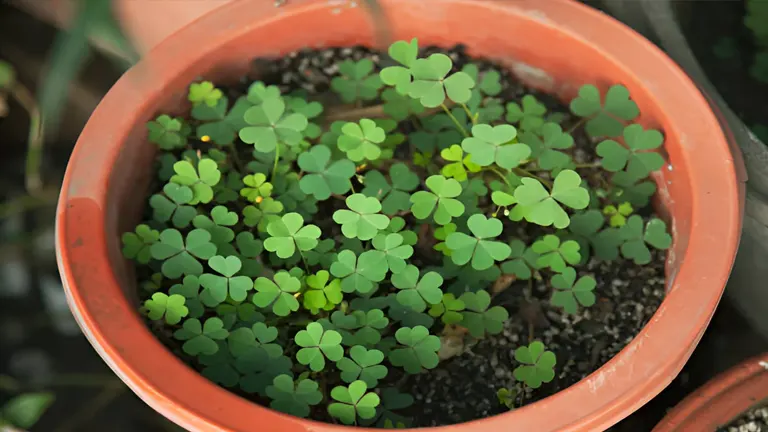
Creating and caring for a clover lawn, whether you’re starting from scratch or enhancing an existing lawn, involves specific steps tailored to each situation:
Starting a New Lawn
- Soil Preparation: Begin by preparing your site. If starting with bare soil, it’s beneficial to mix clover seeds with other grass types. This diversity ensures more uniform coverage and resilience, helping the lawn withstand various conditions such as shade or high foot traffic.
- Seed Selection: Choose a mix that suits your local climate and soil type. For areas with compacted or clay-heavy soil, the addition of grass seeds can help buffer the slower establishment rate of clover.
- Planting: Sow your seed mix evenly across the prepared soil. The best times for planting are typically spring and fall when temperatures are cooler and rainfall more plentiful.
Overseeding an Existing Lawn
- Preparation: Mow your existing lawn low and rake lightly to remove debris and loosen the top layer of soil. This helps the new clover seeds make contact with the soil.
- Seeding: Broadcast a mixture of sprouted clover seeds and peat over your existing lawn. The peat helps maintain moisture around the seeds, improving germination rates.
- Watering: After seeding, water the area lightly but consistently to keep the soil moist until the new clover seeds have fully germinated and started to establish.
Maintenance Tips
- Watering: Clover requires less water than traditional lawns but keeping the soil slightly moist in the early stages of growth will help establish a healthier lawn.
- Mowing: Clover lawns need less frequent mowing. Allow the clover to flower occasionally to encourage self-seeding, which helps maintain the density and health of the lawn.
- Fertilization: Avoid high-nitrogen fertilizers as clover fixes its own nitrogen. If needed, use fertilizers formulated for legumes or organic options to gently boost soil fertility without overwhelming the clover.
Regular Care for Clover Lawns
Watering
During the establishment phase, it’s crucial to give your clover seedlings plenty of attention when it comes to watering. Immediately after planting, ensure you water them lightly but frequently—aiming for twice daily. This regimen supports the seedlings in establishing robust root systems and encourages strong early growth, which is vital for a healthy start.
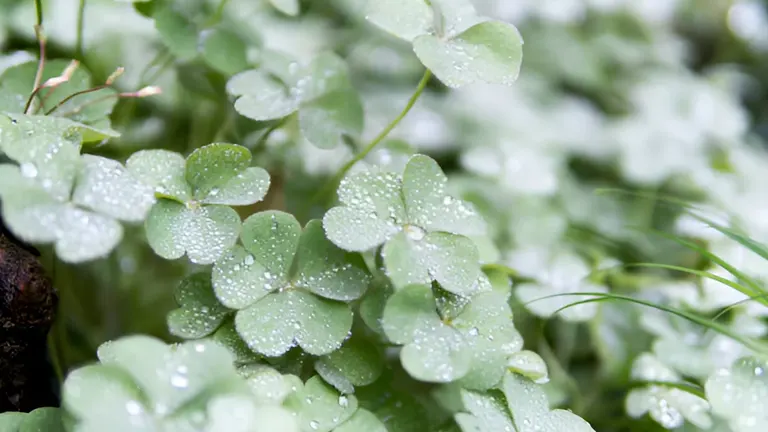
Once your clover lawn is established, the watering needs decrease significantly compared to traditional grass lawns. Clover is naturally more drought-resistant, so it only needs additional watering during prolonged dry periods. This reduced need for water not only makes clover an eco-friendly option but also eases your gardening workload.
Mowing
When it comes to mowing, there are a couple of considerations to keep in mind to maintain the health and appearance of your clover lawn. Firstly, allow your clover to flower occasionally before you mow. This flowering phase is crucial as it allows the plants to spread their seeds naturally, replenishing your lawn and ensuring its longevity and density. By letting the clover flower, you foster a self-sustaining lawn that maintains its vigor over time.
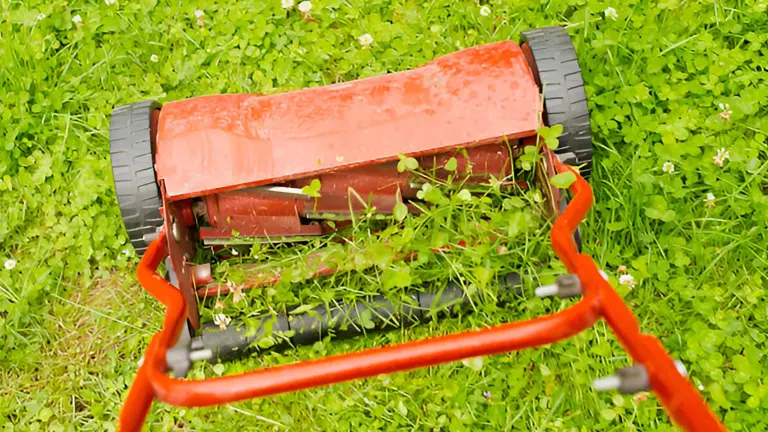
In terms of mowing frequency, clover lawns require less frequent cutting compared to traditional lawns. Typically, you can mow a clover lawn every 3-4 weeks, depending on how you want it to look and the specific conditions of your garden. This less stringent mowing schedule not only helps maintain an optimal height for health and aesthetics but also reduces the amount of labor and time spent on lawn maintenance.
Conclusion
Clover lawns are not only an eco-friendly choice but they also add a distinct charm and simplicity to your outdoor space. With their ease of maintenance and numerous environmental benefits—such as nitrogen fixation and enhanced soil health—clover lawns are an excellent alternative for those looking to reduce their lawn care workload and environmental impact. Whether you’re drawn to their low-maintenance nature or their ability to promote biodiversity, choosing Clover can transform your garden into a sustainable and inviting space.
FAQs
- Is clover safe for pets?
Yes, clover is generally safe for pets. Unlike some traditional lawn treatments that require chemical fertilizers and pesticides, clover is natural and non-toxic. However, be mindful that bees are attracted to clover flowers, which could pose a risk to curious pets. - Does clover attract bees?
Yes, clover flowers are attractive to bees, which makes them excellent for promoting pollinator activity in your garden. While beneficial for the environment, this can be a concern for those with bee allergies or small children. Regular mowing to keep the flowers at bay can minimize this issue. - Can clover become invasive?
Clover can spread aggressively if not properly managed. It’s robust and can encroach on other areas of your garden or landscape. Regular maintenance and border management can help control its spread. - How often should I water my clover lawn?
Initially, clover needs to be watered frequently to establish roots, generally twice a day. Once established, clover is relatively drought-tolerant and requires much less water than traditional grasses. - Do I need to fertilize a clover lawn?
Clover naturally fixes nitrogen in the soil, so additional fertilization is not usually necessary. Applying high-nitrogen fertilizers can actually harm the clover and disrupt its natural growth processes. - Will clover choke out other plants?
Clover can be competitive with other lawn grasses but usually coexists well when mixed properly. It’s beneficial in that it can outcompete weeds, reducing the need for herbicides. - What type of soil is best for clover?
Clover is adaptable to a variety of soil conditions but thrives best in well-drained soils. It’s less suitable for very wet or waterlogged soils, where it might struggle to survive. - How do I start a clover lawn from scratch?
To start a clover lawn, clear the area of existing vegetation, spread clover seeds evenly over the soil, and lightly rake them in. Keep the soil moist until the seeds germinate and the clover begins to grow. - Can clover be used in high-traffic areas?
Microclover is particularly resilient and suitable for high-traffic areas due to its compact growth and robust root system. It recovers quickly from foot traffic, making it ideal for family yards and play areas. - How do I manage clover flowering?
To manage flowering, mow the lawn as the flowers begin to appear. This will help keep the bees at bay and maintain a neat lawn appearance while still allowing occasional flowering for natural reseeding.
We hope this guide inspires you to consider a clover lawn for your outdoor space. Have you tried growing clover before, or do you have any questions about getting started? We’d love to hear your thoughts and experiences! Share your stories in the comments below and let’s help each other grow greener, more sustainable gardens together.

Joel Cunningham
Forestry AuthorI'm Joel Cunningham, an expert in pruning and weed management with over a decade of experience. My skills are rooted in formal training and extensive practice, focusing on advanced pruning techniques and efficient weed control. I'm known for my quality work, precision, and deep understanding of plant health and soil dynamics. My contributions extend to educational initiatives where I share sustainable practices and advice, establishing myself as a reliable and authoritative figure in the gardening community.


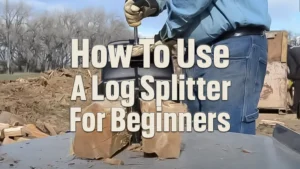





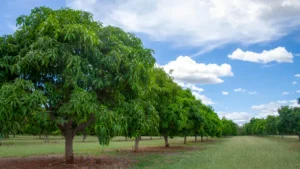




Leave your comment